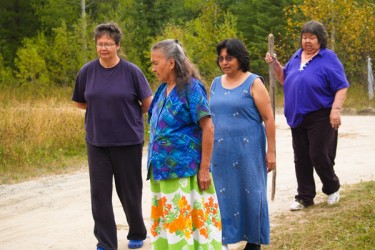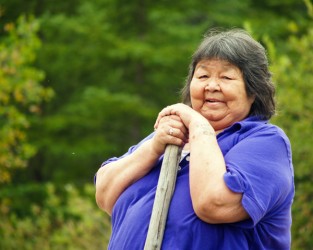Article Origin
Volume
Issue
Year
In 10 years, the small log cabin by Slant Lake–just off-reserve at Asubpeeschoseewagong (Grassy Narrows) First Nation in northwest Ontario–has been home to hundreds, from anti-clearcutting community members to non-Native environmental allies and warriors of other Indigenous nations.
On Dec. 2, the sacred fire by the Slant Lake blockade was re-lit, the one-room cabin warmed, and stories of a decade of Canada’s longest forestry blockade told once again as community members marked the occasion.
“Many people from many different nations have basically been holding strong here,” said Judy da Silva, who organized the blockade a decade ago with her sister Roberta Keesick. “We need to form alliances with many different nations, so we can stand stronger together.
“Because if we don’t walk together on this Earth–this is all our planet–then we lose. The corporations are really powerful. They have a lot of money that we don’t (have). The thing that drives us is our heart. We’re very poor people; but it’s our hearts that make us strong, and keep us going. When we all stand together, we become really powerful.”
The blockade began on Dec. 2, 2002—after months of preparation by Keesick and da Silva’s ad hoc Grassy Narrows Environmental Group—two residents stepped onto the gravel road at Slant Lake and stood, arms raised, in front of a timber-laden logging truck.
Six years, and an international environmental campaign later, the community celebrated as paper giant AbitibiBowater corporation cancelled its logging on Grassy Narrows’ traditional territories. Likewise, the small, remote community fended off Weyerhauser, another multi-national corporation.
Another victory came when the Ontario Superior Court ruled in 2011 that the province was infringing on Aboriginal rights by allowing logging of Crown Lands where operations would harm the Anishinaabe’s traditional way of life–centred around hunting, trapping and fishing. Under the 1873 Treaty 3, that way of life was guaranteed by the Crown, the judge declared.
For blockader Crissy Swain, the blockade was about more than the clear-cut logging. It was about the community coming together for future generations.
“What really pushed me was my children, wanting to make sure they have what I had, and how to survive,” Swain told Birchbark as she sat by the crackling sacred fire that has remained lit for much of the past decade at Slant Lake.
“If it’s up to us now to teach our children, then we need to do something to stop the clear-cutting so that we’re able to teach them those things.”
Swain remembers the day she decided to block the trucks and take a stand. Shortly after her stepfather passed away in 2002, she was driving off the reserve with her sister, discussing how they would pass on his teachings about the land to their children.
“All of a sudden, this big logging truck drove by,” Swain remembered. “We thought, ‘Let’s do it – let’s stop it!’
“We went home, found a babysitter and told them we were going out to get wood. We drove out, and we kept stopping to offer tobacco to the trees. I would say it was for our children and to protect the land. That was part of initiating what was coming. A few days later, on Dec. 2, I came up here and I remember seeing young people laying on the road, and a lot of people from my community out. At that time (...) I never pictured 10 years!”
For Shoon Keewatin, founder of the Grassy Narrows Trappers Centre and a local addictions counsellor, the blockade was part of a long history of community struggle.
Like most reserves, Grassy Narrows has faced a litany of crises. Many children were abused in residential school. The band itself was relocated from their remote islands across the lake to the current site, accessible by road from the town of Kenora, one hour away. In the 1980s, Dryden Chemicals dumped tonnes of deadly mercury into the English-Wabigoon river system, poisoning the waterway and contaminating the fish.
Keewatin said the loss of their main source of food and livelihood led many to alcoholism. And though the health impacts of that disaster remain today, the clear-cut logging was simply the last straw.
“It’s another thing they’re taking away from us, from our people,” Keewatin said. “They’re removing one more thing from us being a people. First they took our language in residential school. Then it was our fishing and the mercury in the river system. Now it’s the logging.”
But the hunter, fisher and trapper, who built the Slant Lake cabin with local youth, told Birchbark that there is also much to be celebrated about the blockade, despite slow progress negotiating with the province. But the gains were not merely political.
“They’ve stopped the clear-cutting and made the province listen,” he said.
“For a lot of the young people, I think it’s made them more aware of the land around them, and how much they’re connected to it. Especially the youth I was working with when we were building the log cabin. They suddenly realized how connected they were to the land.”
Of the young people who mobilized around her community’s blockade, Swain concurs.
“I feel like in the last 10 years I’ve been really discovering myself, and discovering our true history,” Swain said. “My eyes are open more to the way the world is; it’s teaching me what I really want.
“Even after 10 years, it feels good to know we’re still inspiring people. I still have hope, and I still have that fire in me.”
- 2169 views


